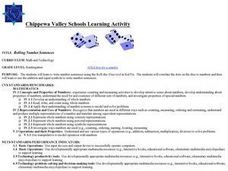Curated OER
Rolling Number Sentences
Budding mathematicians investigate how to write number sentences using the Roll-the-Dice tool in "Kid Pix". They correlate the dots on the dice to numbers and then learn to use the addition and equal symbols to write number sentences....
Leadership Challenge
Inspire Students Today to Make a Difference in the Future
Your search for a year's worth of leadership lessons is over! A lesson in a character education series provides a full two semesters of inspiring leadership activities. The resource includes individual and group challenges to ensure a...
Florida Center for Reading Research
Dictionary Cube
Young scholars investigate new vocabulary words with a fun, collaborative activity. Given a deck of word cards, pairs of students flip over one at a time and independently look up the term in a dictionary. They then take turns rolling a...
Computer Science Unplugged
Marching Orders—Programming Languages
Computers need precise directions to complete a task. Class members experience what it is like to program a computer with an activity that asks one pupil to describe an image while classmates follow the directions to duplicate the picture.
Common Sense Media
Digital Citizenship Pledge Poster
How can your class members show their dedication to digital citizenship? Have them read, add to, and sign this poster. Among several speech bubbles filled in with ways to be an excellent digital citizen are two blank bubbles that you can...
Curated OER
Basic Algebra and Computers: Spreadsheets, Charts, and Simple Line Graphs
Students, while in the computer lab, assess how to use Microsoft Excel as a "graphing calculator." They view visual representations of line graphs in a Cartesian plane while incorporating basic skills for using Excel productively.
Curated OER
Clothes
In this parts of speech online interactive worksheet, students choose the appropriate multiple choice word to describe 9 pictures of clothing. Students type in a word to describe 3 additional pictures of clothing. Students fill in...
Curated OER
Creating a Timeline and Scanning a Photograph
Students create a timeline and scan pictures for it. In this timeline instructional activity, students use an interview of a family member to create a timeline for that person. They scan photographs to add to their computer made...
Curated OER
Make a Compare/Contrast Diagram
In this make a compare/contrast diagram worksheet, students use the drawing tools in a word processor to create a diagram by following detailed instructions for each step.
Curated OER
Decoding Information From the Catalog
Fifth graders identify the parts of a print catalog record as a way to find information and the location of a book in the media center. They complete a worksheet about decoding a catalog record, complete a Mad Libs activity online, and...
Curated OER
Shapes and Angles
Are your geometry whizzes learning about angles and shapes? This online activity gives 10 multiple choice questions based on images and word problems. Concepts include deducting angle degree, classifying shapes, and identifying angle...
Curated OER
Photoshop for Fifth Graders: The First Step is Word
Fifth graders create an image in Microsoft Word. In this technology lesson, 5th graders take an image and practice backgrounds, borders, rotation and more. They start with Microsoft Word before trying the Photoshop program.
Curated OER
Lists, Lists, Lists
Pupils identify HTML codes for creating unordered, ordered, and nested lists for a web page, place different list types within HTML documents, and view the changes within web pages.
Science Buddies
Science Buddies: The Pixel Puzzle: Why Video Game Characters Look Better Today
Video games today look better than video games from the 80's, this is because now the number of pixels, or dots on the screen, used to represent video game objects has greatly increased. In the 80's, Mario was no more than 16 pixels tall...













